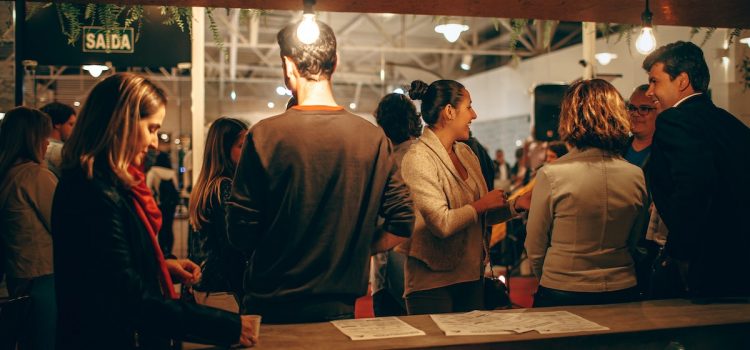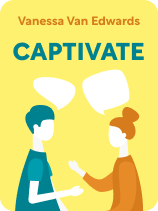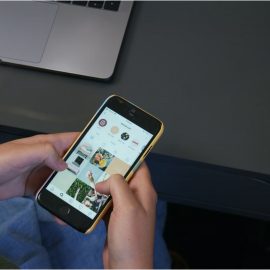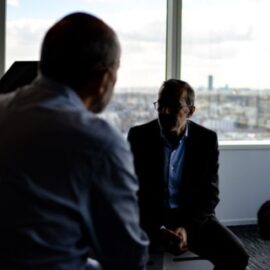

This article is an excerpt from the Shortform book guide to "Captivate" by Vanessa Van Edwards. Shortform has the world's best summaries and analyses of books you should be reading.
Like this article? Sign up for a free trial here.
Are you more comfortable in a cafe or a club? When’s the right time—and what’s the right place—to approach someone in a social setting?
Vanessa Van Edwards says that getting people to like you begins with proactively setting the stage before you meet them. She recommends carefully selecting the places and events you attend, where and how you interact with people once you’re there, and the types of people you interact with.
Keep reading for Van Edwards’s advice on how to be more comfortable in social situations.
Make Social Situations Work for You
Once you learn how to be more comfortable in social situations, you’ll project confidence, and people will respond positively. Follow these steps to get that comfort and confidence.
Step 1: Attend Events Where You’ll Feel Most Confident and Comfortable
Van Edwards recommends making a list of all the settings you love, loathe, and feel okay about, then accept invitations in places you love, reject ones in places you loathe, and take time to consider the ones that are in the locations you feel “okay” in. For example, do you find bars loud and overwhelming? If so, they’re not the place to spend your time if you can avoid them, because you’ll probably be miserable and project a version of yourself that will repel others. Do you love the feel of an intimate coffeehouse? If so, go there, because you’ll feel in your element and will naturally project confidence that will attract others.
Step 2: Position Yourself in the Right Place in the Room
Once you’ve homed in on the type of settings where you function best, your second step is to increase your odds of having positive interactions with people in them.
Van Edwards recommends that you interact with people in the places and at the times when they’re most likely to be receptive to conversation. In general, this means approaching people once they’re settled in, not when they’re in transition—for example, arriving at or leaving an event, getting drinks at the bar, or using the bathroom. Van Edwards says the best locations and times to engage with people are:
- Near the bar, once people have gotten their drinks and are looking to socialize
- With the host, who can introduce you to other people
- Where people are sitting and eating and are open to company and conversation
Step 3: Approach Your People, Not All People
After you’ve found the ideal place to approach people, your next step is to think about the types of people you want to form connections with. Van Edwards argues that you should forge relationships only with people who make you feel good because, when you’re surrounded by people who value and support you, you’re more likely to succeed. She asserts that you shouldn’t incorporate or tolerate toxic people in your life, as they’re a drain on your emotional resources.
To identify people you want to establish deeper connections with personally and professionally, Van Edwards recommends that you start by thinking about people currently in your life who value and support you, so you can be on the lookout for people with similar characteristics. These might be people who eagerly help you achieve your personal and professional goals, who you feel comfortable reaching out to in a time of crisis, or who simply make you feel good about yourself.
| More Strategies to Navigate Social Situations Avoiding toxic people and settings you loathe, and approaching people only once they are settled are practical strategies when you’re in control of the situation. But what if you have to be somewhere you hate? Is it possible to avoid toxic people completely? Here are a few more strategies that you can pair with Van Edwards’s advice so that you have the upper hand in any situation. How to cope in settings you loathe: Van Edwards asserts that her tips for positioning yourself in the right place in the room and knowing which people to approach will help you navigate events in settings you loathe. However, you may benefit from having a few additional coping strategies as backup, such as staying focused on the reason you’re at the event, finding a spot to hide for a few minutes to compose yourself if you need a break, and promising yourself a reward after getting through it.) How to make timing work for you: Though Van Edwards advises you to wait until people are fully settled to talk with them, not every event is the same, so you may benefit from being flexible in your strategy. For example, at industry conferences, you can increase your chances of finding people who want to talk with you by arriving early to get one-on-one time with speakers, organizers, and panelists and inviting new people to join your conversation once you’ve established a connection with a group. How to recognize toxic people: No matter where you go, Van Edwards’s recommendation that you steer clear of toxic people always holds—but how can you recognize them? Begin by paying attention to how each person you meet makes you feel and observing their behavior with others. Some red flags to look for: • If interactions with a particular person leave you feeling anxious, angry, manipulated, guilty, or bad about yourself • If you notice that drama follows this person like a shadow • If this person constantly judges other people and views everyone else as the problem |

———End of Preview———
Like what you just read? Read the rest of the world's best book summary and analysis of Vanessa Van Edwards's "Captivate" at Shortform.
Here's what you'll find in our full Captivate summary:
- How socially awkward people can become social superstars
- How to make yourself likable and memorable
- Methods to establish and improve relationships with others






